Albar Sonic
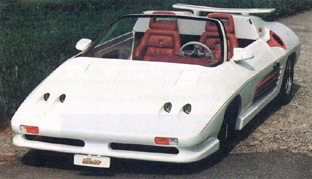
| Year
(of specifications) |
1982 |
| Engine |
- |
| Transmission |
- |
| Max
speed |
- |
| 0-60
mph |
- |
| Horsepower |
- |
| weight |
- |
The 1982 Albar Sonic was an attempt to design an
affordable sports car which had a slippery wedge-shaped
profile.
The Sonic had numerous vents to funnel cooling air
to the rear mounted engine. Powering the car was
a Volkswagen Beetle drivetrain.
Needless to say the performance of the Albar Sonic
was about as unimpressive as the fiberglass bodywork.
Alfa Romeo Disco Volante
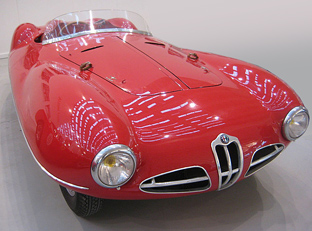
| Year |
1952 - 1953 |
| Engine |
3.5
litre inline 6 cylinder |
| Transmission |
manual
RWD |
| Max
speed |
150
mph |
| 0-60
mph |
- |
| Horsepower |
260
bhp |
| weight |
- |
The Alfa Romeo Disco Volante was an extremely voluptuous
sports car which was unveiled in 1952.
The name of the Alfa Romeo Disco Volante meant 'Flying
Saucer' in Italian. A very appropriate name for
such a striking vehicle.
Only four examples were built, and its primary mission
was to win races. Which it did, but not many. You
see, the gorgeous, slippery shape of the vehicle
- while it created very little drag - it also generated
lift at speed. This made the handling more than
a little bit precarious!
Three different bodystyles and two different drivetrains
were used for the car, including; one open roadster
and two different coupe styles. Most of the cars
features a 1.9 litre inline 4 cylinder which produced
158 horsepower. One car, which was specially built
for Juan Manuel Fangio (a legendary old-school F1
driver), featured a 260 horsepower, 3.5 litre inline
6 cylinder.
Alpine A110
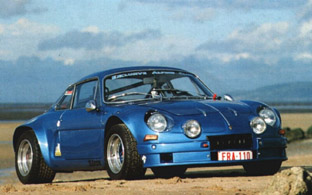
| Year |
1963 - 1977 |
| Engine |
1.1
L - 1.8 L |
| Transmission |
- |
| Max
speed |
- |
| 0-60
mph |
- |
| Horsepower |
87
bhp - 180 bhp |
| weight |
- |
Alpine sold their A110 through Renault dealerships
and the A110 came with a full warranty.
In competition spec the Alpine A110 was a formidable
and successful rally car and in 1971 Alpine was
named Renault's competition arm.
APAL Coupe 1200
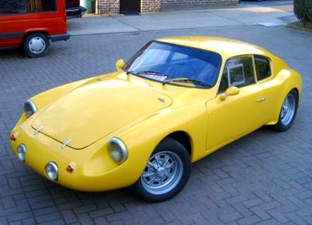
| Year
(of specifications) |
1961 - 1965 |
| Engine |
VW
1200 cc Aircooled |
| Transmission |
- |
| Max
speed |
- |
| 0-60
mph |
- |
| Horsepower |
- |
| weight |
- |
APAL,
standing for 'Application Polyester Armé de Liège'
were a Belgian sports car company founded in 1961
by glass-fibre specialist Edmond Pery. The Apal
Coupe 1200 was one of his first models and is an
attractive coupe with curvaceous styling.
In total roughly 150 Apal Coupe's were made, they
were based on a VW floorplan and power came from
either a 1200 cc Volkswagen aircooled engine or
a rarer Porsche power unit was also available.
The car pictured here is an early version of the
Apal Coupe 1200 restored in 2005 and is owned by
Roland Buyse of Belgium.
Arnolt-Bristol Bolide
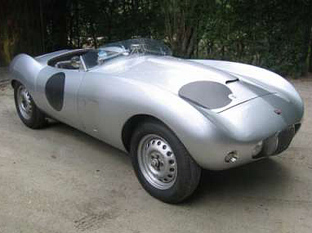
| Year
(of specifications) |
1954 - 1961 |
| Engine |
2.0
litre inline 6 cylinder |
| Transmission |
4
speed manual RWD |
| Max
speed |
- |
| 0-60
mph |
- |
| Horsepower |
130
hp @ 5,500 rpm |
| weight |
930
kgs / 2,050 lbs |
Like the AC Cobra, the Arnolt-Bristol series of
cars were the result of some sort of Anglo-American
collaboration. Except whereas the AC consisted of
a British chassis and an American engine, the Arnolt-Bristol
was a British chassis, German engine, Italian styling
and developed with US financing.
S. H. Arnolt of Chicago was the man responsible
for bringing the project together. While vice-president
of the Italian styling firm Bertone, Arnolt decided
to get Bertone's designers to come up with a curvaceous
roadster based on the Bristol 404 chassis. Into
this was fitted a BMW derived inline 6 cylinder
engine, and then the cars were taken exclusively
to North America for sale. Truly this was an international
design.
The Bolide model was a stripped down racer version
of the Arnolt-Bristol. The engine pumped out 130
hp @ 5,500 rpm and 128 lb-ft of torque @ 5,000 rpm.
Not staggering numbers these days, but at the time
- and in a lightweight car with a competent chassis
- this proved to be more than adequate.
In total 142 Arnolt-Bristols were produced.
Engine and chassis were Bristol, The Bristol in-line
6-cylinder engine had originally in the 400, 401
& 403 cars an interesting arrangement of pushrod
operated valves from a side camshaft, with one bank
of valves being driven by a side-pushrod and bellcrank
arrangement, so the valves were inclined as in a
DOHC layout. This Bristol engine had 3 carbs, with
Y-shaped inlet ports each to a pair of cylinders.
This Bristol engine was also in the AC Ace and optional
(for extra cash) in the AC Aceca.
Bitter CD
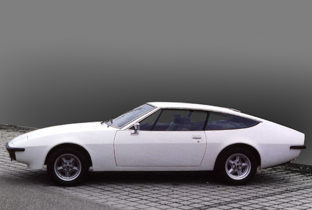
| Year
(of specifications) |
1971 - 1979 |
| Engine |
5354
cc V8 |
| Transmission |
3
speed automatic RWD |
| Max
speed |
129
mph |
| 0-60
mph |
- |
| Horsepower |
230
bhp @ 4700 rpm |
| weight |
- |
The Bitter CD was originally an Opel concept displayed
in 1969 and 1970. When Opel decided not to put the
CD into production Erich Bitter stepped in and purchased
the project.
Production of the Bitter CD began in 1971 and was
based on a shortened Opel Diplomat chassis, the
suspension was revised to handle the lighter CD
but otherwise the running gear remained much the
same.
Power for the Bitter CD came from a 5.4 litre V8
developing 230 horsepower.
Bizzarrini Strada
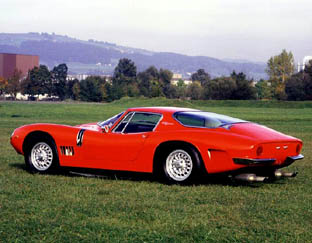
| Year
(of specifications) |
1965 - 1969 |
| Engine |
5.4
litre V8 Chevrolet |
| Transmission |
4
speed manual RWD |
| Max
speed |
174
mph |
| 0-60
mph |
6.4
seconds |
| Horsepower |
365
bhp |
| weight |
- |
The story of Bizzarrini 5300 GT Strada is a kind
of dream came true story. Although Giotto Bizzarrini
has already firmed some of the exotic projects for
most revered names in the sports car world such
as 250 SWB, GTO and Testa Rossa for Enzo Ferrari
or Iso Grifo for Iso Rivolta and vas involved by
Ferruccio Lamborghini in Miura project as engine
chief engineer, his secret desire was to realize
a car that would bear his own name.
Bizzarrini was remarkable character with clear ideas
about sports car and even some experience as a factory
owner being for some time proprietor of ATS together
with Chiti and Conte Volpi di Misurata, but he was
also decidedly an artist as well as a designer,
requiring his cars and engines to look as well as
they performed.
That's why, when he started with his idea of making
the first "Real Bizzarrini", still under
the contract with Iso Rivolta, he engaged another
wonder boy of Italian car body design, Giorgetto
Giugiaro, that executed a beautiful coachwork for
extremely low (111 cm) road raptor with unmistakable
smell of circuits. A legend was born.
This superb machine was born at wrong time when
oncoming oil crisis has already decreed the end
of that magic moment that European GT car production
lived. The Golden Age of supercar adventure was
passing remorselessly but the Bizzarrini dream entered
the hall of fame.
Although the entire story of Bizzarrini car factory
occupied a mere 3 years of existence, no marquee
more nobly painted the idea of mighty, yet elegant
and refined road racer. In the early 1960s, that
was leading concept of major European top car builders.
Sports car racing absorbed much time and money,
but Giotto Bizzarrini has learned in the temple
of racing, as a chief engineer of Scuderia Ferrari,
that only the circuits could crown the successful
projects, and that's the reason that he developed
his car as a natural heir of group 6 prototypes
that dominated the scene in world racing, mixing
together ennobled and sophisticated chassis and
suspension with huge American engine capable of
various stages of tuning. Despite the fact that
Bizzarrini was the father of such a jewel as Lamborghini
Miura V 12 engine, he chose Chevrolet Corvette 5,
4 l alloy motor suitable for extreme tuning and
preserving at the same time its natural tremendous
torque.
The car appeared for the first time at Turin show
in 1963 at Iso Rivolta stand under the name of ISO
150A3C moved with Chevy engine tuned to a 410 bhp
and stated to 305 kph of maximum speed. It looked
impressive with its body of nude aluminium just
riveted to a monocoque chassis.
The engine was pushed back in the front part of
the chassis to equilibrate the weights, and occupied
partly cockpit producing a kind of hell temperature
in such narrow space, making the car decidedly not
suitable for daily street use. However, despite
its racing origins it was never developed as a competition
car and later, when Bizzarini in 1966 started the
production in his own factory and under his name
in Livorno, the car was detuned to 'only' 365 bhp
and 'only' 280 kph, the heating problem in cockpit
was fixed, the rear window was enlarged and the
car offered in the States as "3500 GT".
But the game was over. Although Bizzarrini 5300
GT Strada remain instantly recognizable throughout
the sports car history, the fact is that only 107
of this superb thoroughbreds were assembled, and
its uncompromising character where performance had
absolute priority over other considerations, could
not save this masterpiece from general catastrophic
decline of the world of supercars at the end of
decade.
Giotto Bizzarrini closed his activity in 1969, promising
some better days and even better thoroughbreds in
the future, but the season of the miracles has passed
forever?
Cisitalia 202 Coupe
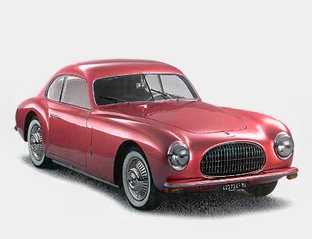
| Year
(of specifications) |
1948 - 1952 |
| Engine |
1089
cc inline four cylinder |
| Transmission |
4
speed manual RWD |
| Max
speed |
105
mph |
| 0-60
mph |
- |
| Horsepower |
50
bhp |
| weight |
- |
Cisitalia was an Italian company founded in 1946
by racing driver Piero Dusio. The Cisitalia 202
Coupe consisted of a Pininfarina designed body set
over a tube frame.
Cizeta Moroder
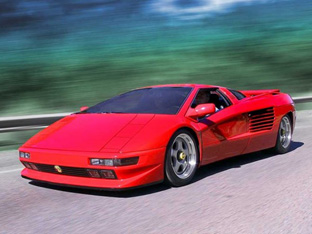
| Year
(of specifications) |
1989 |
| Engine |
6
litre V16 |
| Transmission |
- |
| Max
speed |
204
mph |
| 0-60
mph |
4.0
seconds |
| Horsepower |
560
bhp |
| weight |
- |
The Cizeta Moroder was styled by Marcello Gandini,
the designer responsible for the Lamborghini Miura,
Countach and Diablo, with which the Moroder shares
almost identical lines.
Costin Amigo
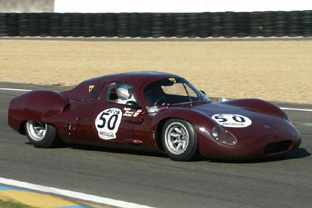
| Year
(of specifications) |
1970 - 1972 |
| Engine |
2279
cc four cylinder |
| Transmission |
- |
| Max
speed |
137
mph |
| 0-60
mph |
7.2
seconds |
| Horsepower |
- |
| weight |
- |
The aerodynamic fibreglass bodied Costin Amigo was
designed by Frank Costin who also designed the Lotus
VIII for Colin Chapman.
Datsun 240Z
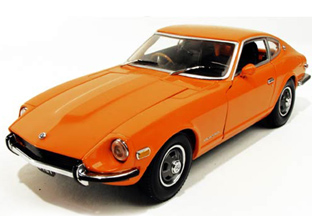
| Year
(of specifications) |
1969 - 1975 |
| Engine |
2392
cc straight 6 |
| Transmission |
4
and 5 speed manual RWD |
| Max
speed |
125
mph |
| 0-60
mph |
- |
| Horsepower |
151
hp |
| weight |
- |
The Datsun 240Z was the first Japanese sports car
to break into the American market and achieve a
large volume of sales. The 240Z was designed by
Albrecht Goertz and featured a long bonet with recessed
round headlights. The roofline of the Datsun 240Z
flowed gracefully into the taught rear arches and
short rear end.
The Datsun 240Z was a superb handling sports car,
helped by the use of Macpherson struts on all four
corners. Inside the driver was offered an array
of five guages, two large main dials for the tach
and speedo directly behind the steering wheel, and
three smaller dials above the centre console.
To this day the Datsun 240Z, and to a lesser extent
the 260Z and 280Z, remain collectors favorites.
Falcon Caribbean
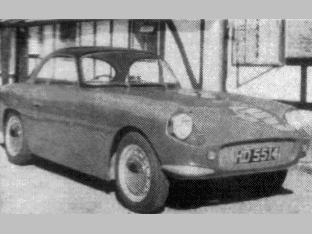
| Year
(of specifications) |
1959 - 1963 |
| Engine |
various |
| Transmission |
- |
| Max
speed |
- |
| 0-60
mph |
- |
| Horsepower |
- |
| weight |
- |
Originally called the Mark 3, the Falcon Caribbean
was primarily intended for the Ford 7 ft 6 in chassis,
but would fit several other chassis of similar wheelbase.
In 1960 the Caribbean became available as a complete
kit, with a choice of engines including the Ford
100E and 105E, Coventry-Climax 1098cc & 1216cc
and MGA. The Falcon Caribbean was a pretty, Italian-inspired
two seater that proved most popular in coupe form,
although a convertible version was also available.
It was estimated that more than 2,000 Falcon Caribbean's
were produced between 1959 and 1963.
Thanks to Chris Thomas for the information.
Ford RS200
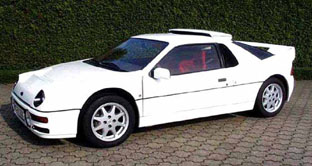
| Year
(of specifications) |
1985 - 1986 |
| Engine |
turbocharged
1803 cc cosworth |
| Transmission |
5
speed manual |
| Max
speed |
140
mph (road spec) |
| 0-60
mph |
6
seconds (road spec) |
| Horsepower |
250
bhp road / 450bhp works |
| weight |
- |
Ford spent millions developing the RS200 to battle
the Audi Quattro in Group B rally races. In order
to comply with homologation regulations 200 road
going Ford RS200's were built by Reliant of Tamworth,
UK.
The tamed road versions were far less powerful than
their racing counterparts but nevertheless still
potent back road machines, in the right hands.
After Group B rallying was banned due to safety
regulations, Ford sold the remaining production
run of RS200's as Ghia spec road cars to private
collectors and enthusiasts.
Fit and finnish are poor, they are meant for racing
not posing. And driven at normal speeds the RS200
is a handful, the car is best used as it was originally
designed.
Ikenga MkII
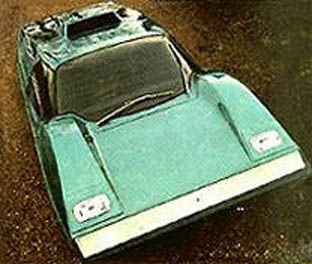
| Year
(of specifications) |
1968 |
| Engine |
Chevrolet
5.3 V8 |
| Transmission |
5
speed manual |
| Max
speed |
162
mph |
| 0-60
mph |
- |
| Horsepower |
- |
| weight |
- |
Thanks to David Gittens, the Ikenga's designer,
for the information below.
The Ikenga MKII was the second of three designs,
all of which were based on the McLaren M1B tubular
chassis. These were the last of the tube chassis
before the M6s which were monocoque. The photo shown
is from a 1969 cover photo feature in Car & Driver
magazine.
The MKl, MKII, and MKIII were 1967,1968, and 1969
concepts with the latter being the most successful
having been featured in Paris and at the Turin Auto
Show in the autumn of 1969 and the Swedish auto
show in March of 1970.
Isdera Imperator
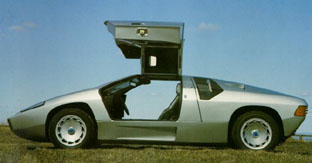
| Year
(of specifications) |
1990 |
| Engine |
Mercedes
or Porsche V8 |
| Transmission |
- |
| Max
speed |
- |
| 0-60
mph |
sub
5 seconds |
| Horsepower |
- |
| weight |
- |
The Isdera Imperator was initially offered with
either a Mercedes or Porsche V8, by 1990 the options
were 3 - 6 litre Mercedes units. The Imperator's
fibreglass body is built on a tubular frame. Interestingly
the Imperator featured a periscope-style rear view
mirror.
Iso Lele Sport
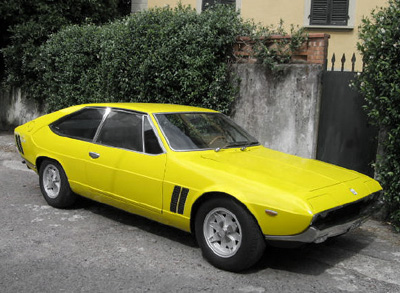
| Year
(of specifications) |
1970 - 1974 |
| Engine |
5.7
litre Ford Cobra Jet V8 |
| Transmission |
ZF
5-speed manual RWD |
| Max
speed |
145
mph |
| 0-60
mph |
- |
| Horsepower |
360
hp |
| weight |
- |
The Iso Lele Sport model was a lightweight, high-performance
variant of the Iso Lele.
The Iso Lele Sport was produced in very limited
numbers, in fact only 24 were built.
Power for the Iso Lele Sport came from a 5.7 litre
Cobra Jet V8 engine, which allowed for a 145 mph
top speed.
Jaguar SS100
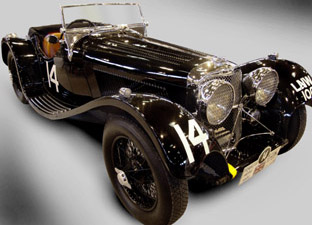
| Year
(of specifications) |
1936 - 1940 |
| Engine |
2.5
(later 3.5) litre |
| Transmission |
4
speed manual RWD |
| Max
speed |
100
mph (est) |
| 0-60
mph |
12
seconds (est) |
| Horsepower |
100
hp (later 125 hp) |
| weight |
- |
The Jaguar SS100 was a sports car produced from
1936 to 1940 by SS Cars Ltd based in Coventry, England.
The company name of 'SS' was changed to Jaguar after
the end of the Second World War due to the association
with the infamous German military unit.
When the Jaguar SS100 was initially introduced it
featured a 2.5 litre in-line six cylinder engine
capable of producing 100 horsepower. Later on in
the SS100's production life, 1938 - 1940, the engine
was upgraded to a 3.5 litre unit developing 125
horsepower.
The Jaguar SS100 featured a 4 speed manual gearbox
with synchromesh on gears 2, 3 and 4.
Only 314 Jaguar SS100s were produced in total, of
these only 49 were exported from England. The successor
to the Jaguar SS100 was Jaguar XK120.
Jaguar XJ13
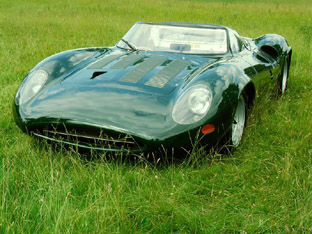
| Year
(of specifications) |
1966 prototype |
| Engine |
5.0
litre V12 |
| Transmission |
- |
| Max
speed |
175
mph |
| 0-60
mph |
- |
| Horsepower |
500
+ hp |
| weight |
- |
The stunning Jaguar XJ13 mid-engine prototype was
tested several times at MIRA (Motor Industry Research
Association) test centre near Nuneaton, England.
The V12 XJ13 was kept secret in order to not interfere
with E-Type sales, potential E-Type purchasers might
prefer the XJ13.
However during a test run the XJ13 suffered tire
failure at 140 mph and the car was destroyed in
the resulting crash, the driver walked away. Two
years later the XJ13 was fully restored by Jaguar
technicians and it now resides in the Jaguar museum.
Jimenez Novia
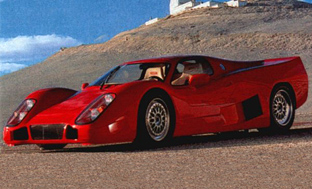
| Year
(of specifications) |
1995 prototype |
| Engine |
4.1
litre W16 |
| Transmission |
- |
| Max
speed |
217
mph |
| 0-60
mph |
- |
| Horsepower |
550
hp |
| weight |
890
kgs / 1962 lbs |
The Jimenez Novia, 'Novia' meaning 'girlfriend'
in Spanish, was a prototype supercar and only one
was ever made.
The Jimenez Novia featured a bizzare drivetrain
which utilized four 1000cc Yamaha motorcycle engines
arranged in a 'W' pattern around a shared crankshaft.
In total this setup developed a mighty 550 horsepower
and allowed for a claimed top speed of 217 mph.
Lamborghini Miura P400 SV
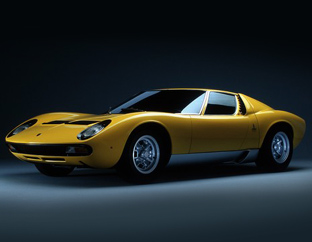
| Year
(of specifications) |
1966 - 1973 (1971 - 1973 SV) |
| Engine |
3929
cc V12 |
| Transmission |
5
speed manual RWD |
| Max
speed |
180
mph |
| 0-60
mph |
- |
| Horsepower |
385
bhp @ 7850 rpm |
| weight |
1245
kgs / 2739 lbs |
The Lamborghini Miura was born at the 1965 Turin
Motor Show where a bodiless P400 chassis was put
on display.
Nuccio Bertone saw the chassis and offered Ferruccio
Lamborghini a body for his creation. The resulting
Lamborghini Miura, designed by Bertone's Marcello
Gandini, was shown at the Geneva Motor Show the
next year.
The public liked the Miura so much that Lamborghini
decided to put the Miura into production - somewhat
hurriedly. Early Miura's suffered from mild defects
and 'niggles', worst of which was a tendency for
front end lift at high speed. However these problems
were gradually eased on later models.
The Miura is a purist supercar, and as such lacks
any home comforts like air conditioning or a radio
- besides the engine noise would have drowned out
anything the radio had to offer.
The legendary Miura was manufactured from 1966 -
1973 with a total of 765 cars produced. The arrival
of the outrageous, and altogether opposite, Lamborghini
Countach effectively ended the Miura's life prematurely.
The P400 SV was the last official incarnation of
the Miura. Lamborghini began producing the Miura
in 1966 with the P400, then in 1968 the Miura P400S
arrived, before being replaced by the Miura P400
SV which ran from 1971 to 1973 when Lamborghini
stopped producing the Miura altogether.
Lancia Rally 037 Evo 2
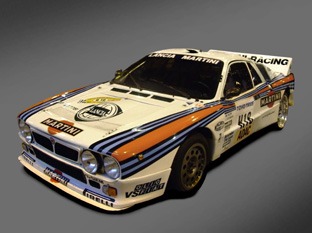
| Year
(of specifications) |
1984 |
| Engine |
2111
cc, supercharged, 4 cyl |
| Transmission |
ZF
DS25/2 5 speed manual |
| Max
speed |
- |
| 0-60
mph |
- |
| Horsepower |
325
bhp @ 8000 rpm |
| weight |
1170
kg / |
The Lancia Rally 037 (also known as the Lancia Abarth
#037) was a mid-engine, rear-wheel-drive rally car
built from 1982 - 1985 to compete in the FIA Group
B World Rally Championship. Unlike its predecessor,
the V6-powered Lancia Stratos, the Lancia Rally
037 had a 2.0 litre 4-cylinder supercharged engine
developing around 250bhp. The power output increased
to 305bhp with the Evolution 1 version introduced
in 1982, and further horsepower gains were made
in 1984 (325 hp) and 1985 (350 hp).
The Lancia Rally 037 was loosely based on its more
common road-going counterpart, the Lancia Monte
Carlo (known as the Scorpion in the US and Canadian
markets). Modifications to the 037 included changes
to the chassis to accept the larger engine, and
increased rigidity for better handling.
The Lancia Rally 037 featured two "humps" in the
roof, these were made to allow room for the crew's
crash helmets because the original roofline hadn't
taken these into account.
Lancia Stratos
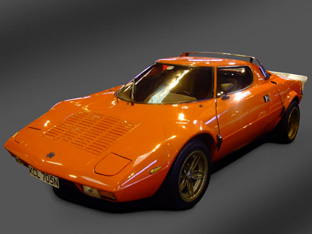
| Year
(of specifications) |
1973 - 1975 |
| Engine |
2.4
litre Ferrari Dino engine |
| Transmission |
5
speed manual |
| Max
speed |
143
mph |
| 0-60
mph |
6.8
seconds |
| Horsepower |
190
bhp standard spec |
| weight |
- |
Review by: Jasper Van Hoorick
There wasn't 500 examples built of the Lancia Stratos,
they were supposed to built 500 to conclude with
race regulations but there are actually between
430 and 480 pieces built. The first 50 cars didn't
have spoilers on the roof and the back of the car,
Lancia added it later because the car was unstable
at high speeds. The first 50 cars also had an air
intake for the "climate control" at the left front
wheel.
The Stratos really brought the spirit back into
lancia for a while, and it still has the world record
of most rally titles in the world. It was one of
the last rally cars without 4 wheel drive.
Although the Lancia Stratos has a really big boot
the car isn't very practical for daily use because
it can be very hot in the cockpit and you have absoluteky
no rear sight, the brakes are very hard and the
electrics are a disgrace. There were many Lancia
Stratos which burnt out because of electrical failures.
There were also 2 long wheelbased Stratos' made
for the use on the circuit and there were also circuit
cars with the ordinary wheelbase but they didn't
handle as well.
Mazda Cosmo 110S
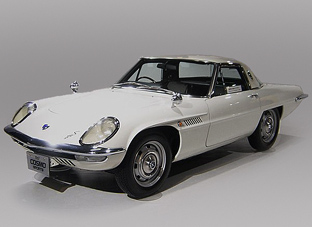
| Year
(of specifications) |
1967 - 1972 |
| Engine |
twin-rotor
Wankel engine |
| Transmission |
4
or 5 speed manual |
| Max
speed |
124
mph |
| 0-60
mph |
8.3
seconds |
| Horsepower |
110
- 128 hp |
| weight |
- |
The first prototype of the Mazda Cosmo 110S was
introduced at the 1964 Tokyo Motor Show, a year
later 80 pre-production Cosmos were manufactured
for the Mazda test department (20) and for dealership
testing (60). Full scale production of the Cosmo
began in May 1967 at a rate of around 1 car per
day due to the fact the cars were hand built.
The Cosmo 110S was a quaintly styled coupe which
appeared to be almost European in style. The Cosmo
was created as a production test bed for the rotary
Wankel engine. In the Cosmo was a twin-rotor unit
which initially produced 110 hp, later cars (1968
- 1972) made around 128 hp. The later cars also
benefited from a slightly longer wheelbase and a
close ratio 5-speed gearbox.
The handling of the Mazda Cosmo was brilliant (partly
due to the lightweight engine) but the ride was
quite hard. A the front was wishbone suspension
and at the rear a live axle with a DeDion tube.
In total just 1,519 Mazda Cosmos were produced between
1967 and 1972. Of these only six were imported to
North America. One of these currently resides in
Jay Leno's garage.
Panther Solo
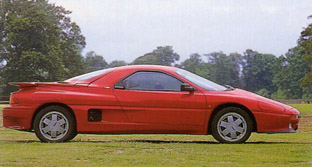
| Year
(of specifications) |
1990 |
| Engine |
Sierra
Cosworth engine |
| Transmission |
AWD |
| Max
speed |
- |
| 0-60
mph |
- |
| Horsepower |
204
bhp |
| weight |
- |
There were only 12 of the 2+2, aluminium monocoque,
carbon fiber reinforced Panther Solo's ever built.
However the press were positive of the Solo when
it first appeared and in another life it could have
done very well.
--------------------------------------------------------------------
Review by: Martin Freestone
I worked as a body designer on the Panther Solo
project from 1987 - 88. All normal automotive methods
were used to design it, no different from an Escort
or Focus. The Koreans had not got a chance to mess
it up before the engineering was pretty much finished.
Piper GTR
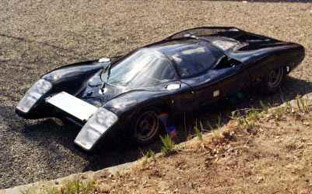
| Year
(of specifications) |
1969 |
| Engine |
2.0L
BMW / Oldsmobile V8 |
| Transmission |
- |
| Max
speed |
- |
| 0-60
mph |
- |
| Horsepower |
- |
| weight |
- |
The Piper GTR was of plywood and fibreglass sandwich
construction. While only four GTR's were completed,
Piper, as a company, lives on in Piper performance
cams.
--------------------------------------------------------------------
Review by: Ian Stanley
The Piper GTR is back. A replica has been made,
produced for racing and track days, with a good
chance of a road legal GTR being made later. Contact
www.piperracingcars.co.uk, (email reference Ian
Stanley). The website has full details and photos
of the Piper GTR with 21st century mechanical engineering
to match the 21st century body aerodynamics
Probe 15
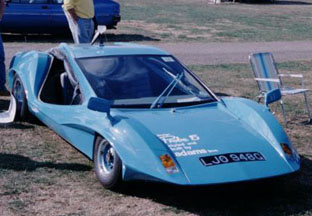
| Year
(of specifications) |
1969 |
| Engine |
Hillman
Imp running gear |
| Transmission |
- |
| Max
speed |
80
mph |
| 0-60
mph |
- |
| Horsepower |
- |
| weight |
- |
The Probe 15 was made famous by the Stanley Kubrick
film 'a clockwork orange'. The Probe 15 was only
29 inches tall making it the lowest car in the world,
the car was so low access to the Probe was through
the sliding roof.
Despite its rapid looks the Probe 15 was based on
Hillman Imp running gear and its performance was
anything but rapid.
Below is an entertaining story sent in to diseno-art.com
by Mike Harrison of Canada about the Probe 15.
It was after the car was purchased by... darned
if I can remember his name... a young man from South
Africa who was training to be a pilot with BOAC.
He was called back to South Africa to attend the
sale of one of his father's farms.
He asked me to drive him to Southampton. He was
going back by boat and was hoping to take the car
with him.
The morning we were due to leave Hertfordshire,
the throttle cable broke. It was actually a bicycle
brake cable and the nipple came off right under
the gas peddle. The owner told me to keep the car,
shook hands, wished me luck and took a cab (all
the way to Southampton!)
He actually left PROBE 15 not in my care but in
the care of a small company named David Johnson
Enterprises, out of Harpenden. There were only four
of us in the company and we specialised in major
promotions using film cars and other traffic building
props.
Our first car was a replica Batmobile, followed
a year later by the 22 foot long, 8 foot wide road
version of FAB 1, Lady Penelope's Pink Rolls Royce,
so PROBE 15, though it hadn't appeared in any films
at the time, was a good fit.
It took me four hours, upside side, sunnyside up,
to attach a solderless nipple to the end of the
brake cable (I'm 6'4" - take a look at the interior
shots to appreciate that particular feat.)
I drove it regularly for about three months and
one of my earliest memories is pulling up at a set
of traffic lights in St.Alban and seeing a baby
in a pram looking down at me.
It actually drove well. Not too fast, my girlfriend
at the time had a Mini Cooper and the Mini would
beat PROBE on the straight, but nothing touched
it in the twisties.
I often drove it home and parked it overnight. I
lived at the end of a narrow cul-de-sac. One morning,
a long haul trucker thought our street offered a
short-cut across town.
Realising his mistake, he compounded it by trying
to turn his rig around and became completely stuck.
His trailer completely blocked the entire street.
Even cyclists were having a hard time getting past.
PROBE 15 handled it beautifully. Since she was only
29" high, I was able to simply drive under the offending
trailer and out the other side.
It always drew a crowd. Especially when you were
trying to get in or out through the roof panel.
Long legged girl passengers in short skirts were
particularly welcome, often receiving an appreciative
round of applause from the onlookers.
My final days with PROBE were less than auspicious.
It was late in the evening, raining, in a built
up neighborhood with cars parked on either side
of a narrow road. Suddenly, a car swung wide around
the approaching bend, headlight full on, taking
up ever inch on my side of the road.
To avert a head-on, I feathered the brakes. Without
warning, the curb-side rear brake locked up solid.
The nose spun sharp left and smacked a parked car.
We were okay but PROBE's front wing disintegrated.
After that, they took away my toy and I had to content
myself with tooling around in the Pink Rolls Royce.
Happy days.
Wonder what ever happened to dear old PROBE?
---------------------------------------------------------------------
Review by: anonymous:
Being a petrolhead since a kid,i was taken aback
one day by a very low and sleek car, parked outside
the parade of shops that i use to live near to.This
turned out to be a Probe, and at that particular
time (around 1976) was lime/pistachio Green. I'm
pretty sure it had a wheel missing, and it seemed
to be parked up/abandoned!.. It stayed there for
about six weeks-ish, before dissapearing. Being
twelve years old at the time, I didn't realize that
one of these cars had been used in A Clockwork Orange
(wasn't it banned at the time?)... Be nice to know
if this car was used in the film, has survived etc,etc..
The shopping parade was woodhall shops in Welwyn
Gdn city.
---------------------------------------------------------------------
Review by: Ewan
For the most authoritve account of the Adams Probe
Series of cars, the Adams Probe 15, the Adams Probe
16 and the Adams Probe 2001 visit www.adamsprobe.com
The site also cover the Concept Centaur GT, a derivative
of the Probe 15.
Vector W8
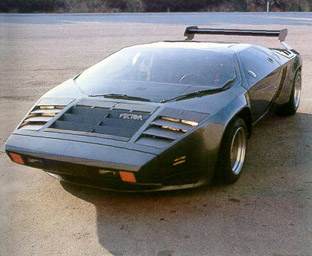
| Year
(of specifications) |
1980 |
| Engine |
5.7
litre Chevrolet twin turbo |
| Transmission |
Oldsmobile
Toronado trans |
| Max
speed |
240
mph (claimed) max boost |
| 0-60
mph |
- |
| Horsepower |
600
bhp |
| weight |
- |
The American made Vector W8 supercar featured gull
wing doors and heated seats among other exotic delights.
Vector has remained tight lipped about the full
specs of the W8 to maintain exclusivity.
Only 17 Vector W8's were produced.
|
Alfa Romeo Carabo
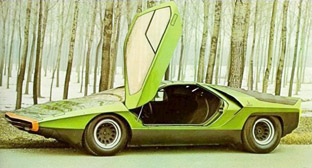
| Year |
1968 |
| Engine |
1995
cc V8 |
| Transmission |
6
manual |
| Max
speed |
155
mph |
| 0-60
mph |
6.4 |
| Horsepower |
230
bhp @ 8800 rpm |
| weight |
1000
kgs / 2205 lbs |
The Alfa Romeo Carabo was a milestone in Supercar
design. Originally penned by Marcello Gandini, from
Bertone, the car was called "Carabo," meaning beetle.
The concept car was shown in October 1968, at Porte
de Versailles in Paris, to a stunned crowd.
It was built on the Chassis of the mid-engined V8
Alfa Romeo Tipo 33 and was an experimental design.
The Lamborghini Miura, also previously designed
by Gandini, had suffered from front-end lift at
high speeds, so the Carabo was an exercise in focusing
on an aerodynamic solution. The car also featured
upward hinging doors, which later inspired the Lamborghini
Countach.
Alfa Romeo Iguana
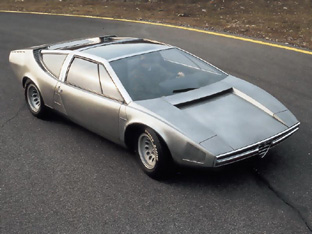
| Year |
1969 |
| Engine |
1995
cc V8 DOHC |
| Transmission |
6
manual RWD |
| Max
speed |
- |
| 0-60
mph |
- |
| Horsepower |
230
bhp @ 8800 rpm |
| weight |
- |
The Alfa Romeo Iguana prototype was based on an
Alfa Romeo 33 Stradale chassis (VIN 750.33.116).
The Iguana concept was designed by Giorgio Giugiaro
and was first presented to the public at the 1969
Turin Motor Show.
A production run was initially planned, however
this was later withdrawn, and the Iguana remains
a one-off.
The Alfa Romeo Iguana features an sleek wedge-shaped
body which is formed from unpainted stainless steel.
The styling of the Alfa Romeo Iguana provided some
of the influence for the later Giugiaro-designed
Maserati Bora and Merak models.
AMC AMX/3
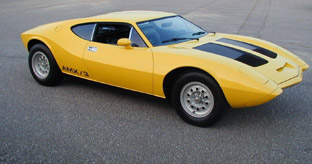
| Year
(of specifications) |
1970 |
| Engine |
6.4
litre V8 |
| Transmission |
- |
| Max
speed |
160
mph |
| 0-60
mph |
6.0
seconds |
| Horsepower |
340
bhp |
| weight |
- |
The AMC AMX/3 featured independent suspension and
a 340 bhp engine which made 430 ft/lbs of torque
at just 3600 rpm.
Only 6 AMX/3's were ever made due to an extremley
high production cost and therefore price.
Argyll Turbo GT
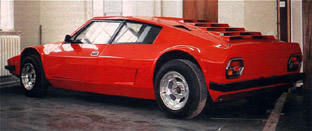
| Year
(of specifications) |
1976 |
| Engine |
turbocharged
V6 or V8 |
| Transmission |
5
speed ZF transaxle |
| Max
speed |
150
Rover, 130 Saab |
| 0-60
mph |
- |
| Horsepower |
- |
| weight |
- |
The Argyll Turbo GT featured a box section chassis
and Triumph 2500 independent suspension.
The Argyll Turbo GT had a longitudinally mounted
V6 engine. It was a 2+2 Tourer. The Turbo GT was
made in Scotland.
Aston Martin DB5
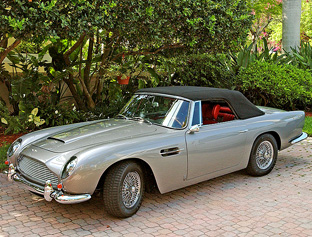
| Year
(of specifications) |
1963 - 1965 |
| Engine |
4.0
litre straight 6 cylinder |
| Transmission |
4
or 5 speed manual / 3 auto RWD |
| Max
speed |
140
mph |
| 0-60
mph |
- |
| Horsepower |
240
- 280 hp |
| weight |
- |
The Aston Martin DB5 was a phenomenally expensive
sports car when it was introduced in 1963 - costing
considerably more than a nice house. In 1964 when
the DB5 was featured in the Bond movie 'Goldfinger'
the Aston Martin name was catapulted into the limelight
around the world, and the 007 association has been
strong ever since.
The DB5 was the fifth Aston Martin model to be built
while the company was owned by David Brown - hence
the DB element to the car's name. David Brown was
an English entrepreneur and founder of a successful
tractor company.
The DB5 was a development of the 3.7 litre DB4.
However the DB5 featured a 240 horsepower, 4.0 litre
engine coupled to a 5 speed ZF transmission when
it was first introduced. The DB5 was capable of
reaching a 140 mph top speed, although the more
powerful DB5 Vantage version could nearly hit 150
mph.
In total 1,018 Aston Martin DB5's were manufactured
from 1963 - 1965. They came in coupe, convertible
and estate versions - although only 12 estates were
built, and these were reserved for special clients
and friends of David Brown.
ATS 2500 GT
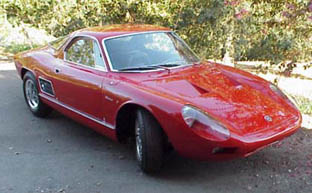
| Year
(of specifications) |
1963 - 1964 |
| Engine |
2.5
litre SOHC V8 |
| Transmission |
5
speed Colotti gearbox |
| Max
speed |
160
mph |
| 0-60
mph |
- |
| Horsepower |
210
bhp road / 245 competion |
| weight |
- |
ATS stands for Automobili Turismo Sport, and the
2500 GT was their first road car, and more significantly,
the first mid-engined Italian road car. Most of
ATS's employees had worked for Ferrari, who they
intended to dethrone. They produced a F1 car which
was a total failure.
Bizzarrini Manta
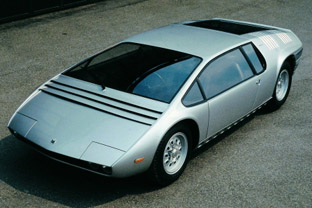
| Year
(of specifications) |
1968 |
| Engine |
5.4
litre V8 Chevrolet |
| Transmission |
5
manual RWD |
| Max
speed |
- |
| 0-60
mph |
- |
| Horsepower |
355
bhp @ 5800 rpm |
| weight |
- |
The Bizzarrini Manta concept was based off the chassis
of the Bizzarrini P538 race car of 1966. The car
was built by Giorgetto Giugiaro to promote Ital
Design. The car was taken to motor shows all over
the world and eventually ended up in the US, where
it got it's current turquoise paint job. An interesting
note, the car was a three seater, with the driver
sitting in the middle.
Bourbon Nicolas Adonis
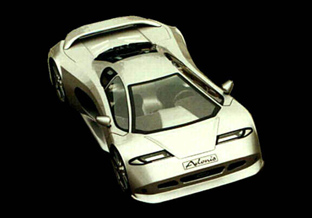
| Year
(of specifications) |
1993 |
| Engine |
5.2
litre V8 |
| Transmission |
5-speed
automatic RWD |
| Max
speed |
205
mph |
| 0-60
mph |
3.3
seconds |
| Horsepower |
420
bhp @ 7000 rpm |
| weight |
- |
The Adonis was the work of Nicolas Bourbon. Working
in his spare time from home he created the car after
an estimated 6,000 hours of work over 5 years. The
Adonis featured pneumatic suspension, inverted mirror
headlights and composite fibre bodywork.
Chaparral 2
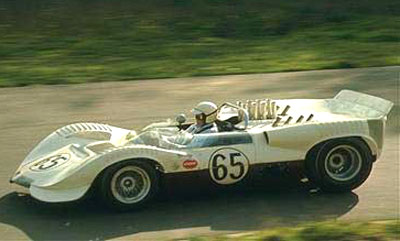
| Year
(of specifications) |
1963 - 1965 |
| Engine |
Chevy
Small block (size varies) |
| Transmission |
4
speed manual, automatic in C model |
| Max
speed |
- |
| 0-60
mph |
- |
| Horsepower |
up
to 480 horsepower |
| weight |
1,600
lbs / 725 kgs |
Review by: Sam Mc.
The Chaparral 2 had three different configurations,
the 2A, 2B, and the 2C. They were designed in Texas
by Jim Hall and had numerous innovations, many of
which were banned shortly after being introduced.
The Chaparral 2A was unsuccessful because of front
end lift at speeds, causing difficult handling,
and was quickly quickly retrofitted and re-designated.
The new Chaparral 2B was, unlike the 2A, extremely
successful in competition, both domestic and international.
The small mid-engined sports racer was nimble in
the corners and fast on the straits. It featured
a cutting edge fiberglass monocoque chassis.
From the 2B evolved the 2C, with an automatic transmission,
which at first may seem odd, until you know that
replacing the clutch pedal with a new third pedal
which, believe it or not, controlled the angle of
the rear wing! Because of this, you could lower
downforce on the straits, increasing speed, and
add downforce in the corners, increasing grip. It
was an ingenious design from an ingenious designer.
Counting the A, B, and C, the Chaparral won 22 out
of the 39 races it entered, an impressive result.
Cheetah
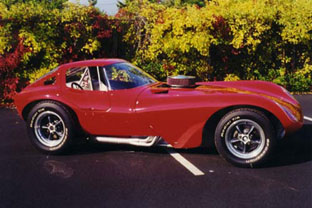
| Year
(of specifications) |
1960 's |
| Engine |
5763cc
V8 |
| Transmission |
ZF
5 speed transaxle |
| Max
speed |
160
mph + |
| 0-60
mph |
5.2
seconds |
| Horsepower |
350
bhp |
| weight |
- |
The
Cheetah was the inspiration for numerous small boys
dreams in the early Sixties (including my own).
Built as a proposal to General Motors as an alternative
to Ford's very successful Cobra project, the Cheetah
employed many of the styling cues that were common
to the era. A long hood and short beck stretched
taught over the biggest motor that could be stuffed
between the wheels.
Like the Cobra, Jaguar's XKE and Chevrolet's own
Gran(d) Sport Sting Ray, the Cheetah was designed
to do one thing very well...GO FAST. Assembled from
off-the-shelf Corvette parts and fabricated frame
and suspension components, the Chevrolet derived
engine was positioned behind the front wheels to
create a front-mid engine arrangement to make a
stable high performance platform. Because the chassis
was not stiff enough, the Cheetah exhibited quirky
handling characteristics at high speeds. The Cheetah
was fast. Speeds of 185 mph were recorded at road
courses, and a claimed 200+ mph is claimed at the
Daytona oval.
Unfortunately, a fire destroyed the Cheetah production
facility and claimed the unfinished cars and more
importantly, the molds and tooling to create more
cars. The fire did not end the Cheetah story though...
Numerous "kit" Cheetahs were attempted, with a few
even being sold. Most of the replica Cheetahs were
of very questionable quality, with poor fit-and-finish
and highly suspect engineering. There are a few
weblogs that chronicle attempts by owners to finish
their kits with various levels of success.
"Cheetah Race Cars" has gotten permission from one
of the original creators of the Cheetah (Thomas)
to create "continuation" cars that are advertised
as faithful to the original with updated engineering
and reliability, but without the problems of the
replicas.
The Cheetah was intended to rival the mighty Cobras.
In some ways it did just that. It certainly looked
the part. The performance was there. It just suffered
the fate of many great dreams... It lacked just
a little bit of good luck. If you happen to live
in Southern California, keep your eyes open. The
few surviving Cheetah's (out of 23 completed) that
still exist are located in that warm and sunny dream-land.
A fitting place for the car of my boyhood dreams.
Daimler SP250 Dart
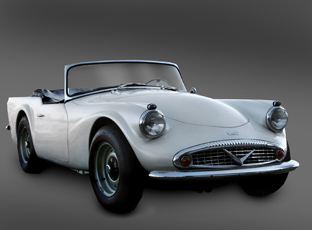
| Year
(of specifications) |
1959 - 1964 |
| Engine |
2548
cc V8 |
| Transmission |
4
speed manual, 3 auto, RWD |
| Max
speed |
125
mph |
| 0-60
mph |
9.5
seconds |
| Horsepower |
- |
| weight |
- |
The decision to create a sports car was a change
of tack for Daimler when, under new management,
the company decided to build the SP250 'Dart'. The
Chassis and layout of the SP250 was taken from the
Triumph TR3. The body was made from fibreglass and
featured some unusual and awkward styling elements.
The 'Dart' name had to be dropped from the SP250
as Dodge held the patent to the name.
--------------------------------------------------------------------
Review by: John Kessler
Two UK guys who I met at a recent car show while
looking at the first one I've seen in 35 years in
USA told me most Brits refer to the SP250 as the
"Catfish", due to its 'unique' front styling.
DeTomaso Mangusta
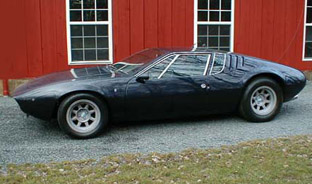
| Year
(of specifications) |
1969 |
| Engine |
4949
cc Ford V8 |
| Transmission |
5
speed RWD |
| Max
speed |
155
mph |
| 0-60
mph |
7
seconds |
| Horsepower |
230
bhp @ 4800 rpm |
| weight |
3050
lbs |
Review by: Richard Sorensen
The sensation of the 1966 Turin Motor Show, this
was the second model from Alejando de Tomaso's stable.
Styled by world famous designer Giorgetto Giugiaro
during his tenure at Ghia it was arguably the world's
first mid-engined sports car when it entered production
in 1967. It was christened 'Mangusta' (Mongoose)
in reference to the legendary AC Cobra with which
it shared it's Shelby modified Ford 289 cu in V8
engine.Chassis construction was a Lotus-style sheet
metal central backbone covered by an all-steel body
including gull-wind engine covers. A total of 401
Mangusta's were built before the model was replaced
by the more mass production oriented Pantera. Of
the 401, only 120 were 'European' Spec with the
302bhp 289cu in engine, the balance were American
spec 302 cu in putting out 230bhp. Later American
cars also featured a less attractive single pop-up
headlamp treatment.
Engine: 4728cc 90 V8
Output: 305bhp @ 6,200rpm (405Nm@4800)
Firing order 1-5-4-2-6-3-7-8
Top speed: 250km/h6500rpm in 5th gear (theoretical)
Stroke & Bore: 72.89mm x 101.6
Compression ratio: 9.8:1
Ford GT70
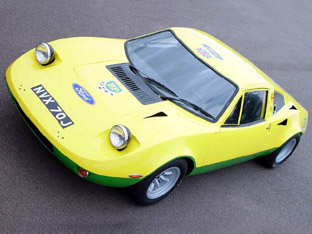
| Year
(of specifications) |
1971 |
| Engine |
2996
cc V6 |
| Transmission |
5
speed manual RWD |
| Max
speed |
155
mph |
| 0-60
mph |
- |
| Horsepower |
128
bhp @ 4750 rpm |
| weight |
762
kgs / 1680 lbs |
There were only 3 Ford GT70's built before the project
was scrapped.
Ginetta G33
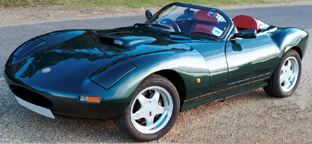
| Year
(of specifications) |
1990 |
| Engine |
3.5
or 3.9 litre Rover V8 |
| Transmission |
- |
| Max
speed |
150
mph aprox (3.9 engine) |
| 0-60
mph |
5.0
seconds (3.9 engine) |
| Horsepower |
- |
| weight |
- |
Review by:: Ginetta G33 Owner
Ginetta G33 1993 model 3.9l V8. 0-60 5 secs, top
speed circa 150 mph.
Pretty and rare. The G33 looks and sounds fantastic,
I get comments every time I drive it, even when
stopped at traffic lights people come and ask about
it.
The car is quite fast with very good handling but
it can "bite" in the wet as there is so much torque.
I find the car comfortable for long distances, but
it is prone to the top leaking a little in very
heavy rain and the hood is not the fastest to put
up.
As a car for warm sunny weekends and the odd trackday
I think it's fantastic, but it wouldn't be suitable
for everyday use.
Simple modifications such as exhaust manifolds,
cam and ecu re-map can make these cars very fast.
Isdera Commendatore 112i
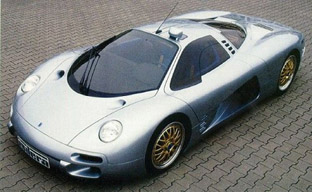
| Year
(of specifications) |
1993 |
| Engine |
Mercedes
12 cyl 5987cc |
| Transmission |
6
manual |
| Max
speed |
205
mph |
| 0-60
mph |
4.7
seconds |
| Horsepower |
408
bhp @ 5200 rpm |
| weight |
1480
kgs / 3263 lbs |
The Isdera Commendatore 112i supercar was the sole
prototype of a made to order supercar. The 112i
was shown at the 1993 Frankfurt Motorshow.
The sleek bodywork was hand built and featured a
roof mounted, periscope-style rear view mirror.
The gullwing doors were matched by gullwing engine
covers hiding a Mercedes Benz 6 litre V12, most
of the other running gear came courtesy of Porsche.
The previously elusive Isdera Commendatore 112i
was put up for sale on e-bay at the end of 2005,
the owner asked for a starting bid of $3,000,000.00.
Iso Grifo
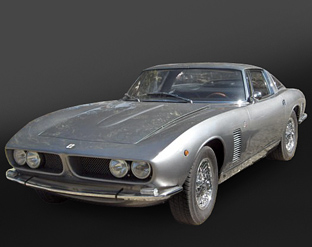
| Year
(of specifications) |
1963 - 1974 |
| Engine |
5.4
litre V8 / 7.0 litre V8 |
| Transmission |
4/5
spd manual, 3 spd auto, RWD |
| Max
speed |
150
- 170 mph |
| 0-60
mph |
- |
| Horsepower |
300
- 390 bhp |
| weight |
- |
The Iso Grifo was a luxurious 2 door coupe derived
from the unfortunatley named Iso Rivolta of 1962.
The Iso Grifo which debuted in 1963 featured a shorter
chassis and flowing coupe lines penned by the Italian
styling house Bertone.
The engine of the Iso Grifo was not of Italian origin,
instead a GM sourced 5.4 litre V8 was used. This
engine produced around 300 horsepower in the standard
model and could propel the car up to 150 mph. A
365 hp version was also available and this was good
for 160 mph. Transmission choices included a four
or five speed manual, or a 3 speed automatic.
In 1968 the Iso Grifo received a larger 7.0 litre
V8, and power output jumped to a very respectable
390 hp. With this new engine the Grifo was capable
of 170 mph.
In the final two years of production the Grifo was
fitted with a Ford 'Cleveland' V8 instead of the
GM unit. Unfortunately Iso struggled during the
fuel crisis of the 1970's and the company was forced
into bankruptcy in 1974. In total 504 Iso Grifo's
were manufactured from 1963 - 1974.
Jaguar E-Type
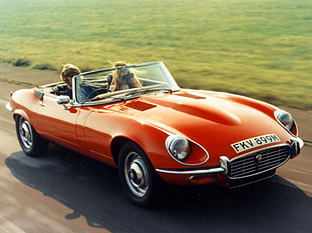
| Year
(of specifications) |
1961 - 1975 |
| Engine |
3.8,
4.2 litre straight 6
5.3 litre V12 |
| Transmission |
4
speed manual / 3 spd auto, RWD |
| Max
speed |
150
mph |
| 0-60
mph |
- |
| Horsepower |
- |
| weight |
- |
The Jaguar E-Type (the car was named the XK-E in
North America) is probably one of the best known
sports cars of all time. At its introduction in
1961 the E-Type offered superb performance at a
price far less than any of its rivals.
The curvaceous yet simple bodywork of the Jaguar
E-Type was inspired by the Le Mans winning Jaguar
D-Type race car. The body proved to be incredibly
stiff and worked extremely well with the wishbone
and coil spring suspension system.
Initially the E-Type was powered by a 3.8 litre
inline 6 cylinder connected to a 4 speed manual
gearbox.
In 1964 the displacement was increased to 4.2 litres
and the transmission and brakes were both upgraded.
The interior was also improved thanks to better
trim and electrics.
In 1966 Jaguar launched a 2+2 version of the E-Type
and an automatic transmission was made available
to appeal to the American market.
1968 saw cosmetic changes to the E-Type which were
essential to comply with new US safety standards.
These modifications resulted in a more cluttered
appearance and lower power due to stricter emissions
regulations.
The final version of the E-Type, the Series 3, was
powered by a 5.3 litre V12. This model could be
identified from the earlier versions due to the
2+2 layout (the 2 seat coupe model was discontinued),
flared wheel arches and a larger grille.
Jensen Interceptor
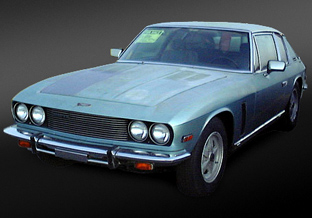
| Year
(of specifications) |
1966 - 1976 |
| Engine |
6.2
/ 7.2 litre V8 |
| Transmission |
4
spd manual / 3 spd auto RWD |
| Max
speed |
- |
| 0-60
mph |
- |
| Horsepower |
390
hp (7.2 litre SP version) |
| weight |
1588
kgs / 3500 lbs |
The Jensen Interceptor was the most successful model
produced by the English manufacturer with 6,408
manufactured over the 10 years it was in production.
The Interceptor was based on the company's previous
model, the CV8, but with striking body work designed
by the Italian coachbuilding firm Carrozzeria Touring.
The Interceptor was initially offered with a 6.2
litre Chrysler V8 under the hood. There were both
automatic and manual versions available and the
power was sent to the rear wheels through a limited
slip differential.
In 1971 the displacement was increased to 7.2 litres
and equipped with a four barrel carburetor. An SP
(six-Pack) version was produced from 1971 - 1973,
this model produced a very healthy 390 hp and was
the most powerful variation of the Interceptor.
The Jensen Interceptor saloon had a distinctive
large, curving wraparound rear window that doubled
as a tailgate. The interior was well appointed and
featured electric windows, reclining front seats,
a wood rimmed steering wheel, radio with twin speakers.
Power steering was fitted as standard later in 1968.
The Jensen Interceptor was produced in three different
forms, the hardtop grand touring version was by
far the most common with over 6,000 made. Only 267
convertibles were produced, and a mere 60 Interceptor
coupes were built.
Lamborghini Espada
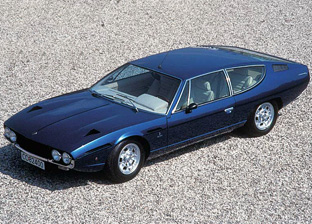
| Year
(of specifications) |
1968 - 1978 |
| Engine |
4.0
litre V12 |
| Transmission |
5
speed manual / 3 auto RWD |
| Max
speed |
150
- 155 mph |
| 0-60
mph |
- |
| Horsepower |
325
- 365 bhp |
| weight |
- |
The Lamborghini Espada was a genuine full four-seat
supercar introduced in 1968.
The styling of the Espada was carried out by the
Italian styling firm Bertone, and featured a distinctive
side window line which swept upward at the rear.
Under the long, wide hood lay a 4.0 litre V12 which
on the first cars put out 325 hp. In 1970 the power
was increased to 350 hp, and in 1972 365 hp.
Initially the Lamborghini Espada was offered solely
with a 5-speed manual gearbox, later a 3-speed automatic
transmission was made available.
While the styling of the Lamborghini Espada is not
to everyones taste, the fact it had four usable
seats, a glorious V12 engine and a Lamborghini badge
made it one of Lamborghini's most popular models.
In total 1217 Espada's were manufactured before
the model was dropped in 1978.
Lamborghini Silhouette
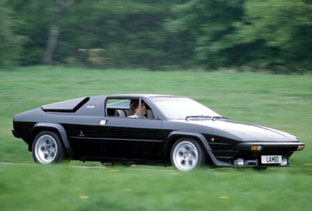
| Year
(of specifications) |
1976 - 1979 |
| Engine |
2996
cc V8 |
| Transmission |
- |
| Max
speed |
161
mph |
| 0-60
mph |
6.5
seconds |
| Horsepower |
260
bhp @ 7500 rpm |
| weight |
1240
kgs / 2751 lbs |
Review by: C. Fox
The Silhouette was an attempt to creat a lower cost,
entry level Lamborghini using the 8 cylinder power
plant of the Urraco. Constructed during hard financial
time few of the lovely cars were built. After Lamborghini
was purchased by the Mimram brothers the car was
reincarnated at the Jalpa with a bigger engine and
more muscular look. The Jalpa was more successful
producing a run of cars almost 10 times greater.
Lancia Delta S4 Strada
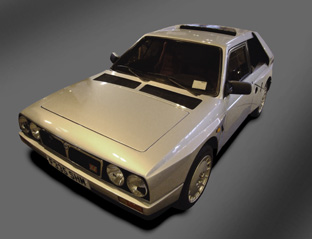
| Year
(of specifications) |
1985 |
| Engine |
1759
cc supercharger & turbo |
| Transmission |
Manual
AWD (adjustable bias) |
| Max
speed |
- |
| 0-60
mph |
- |
| Horsepower |
250
bhp (road) / 550 hp (race) |
| weight |
- |
The Lancia Delta S4 Strada was conceived in 1983,
before going into production in 1985. Only 200 S4
Strada's were produced for homologation purposes
to allow the mighty S4 to compete in the legendary
Group B Rally series.
The S4 name is an abbreviation of supercharged and
4, for four-wheel-drive. The 1759 cc 4 cylinder
engine of the Lancia Delta S4 Strada was force-fed
by both a supercharger and a turbocharger, this
meant the cars immense power was available throughout
a much wider rev range. In road going form the S4
Strada put out around 250 horsepower, but by 1986
some of the race versions were achieving upwards
of 550 horsepower.
The 4-wheel drive transmission of the Lancia Delta
S4 Strada could be adjusted from 75/25 rear/forward
bias, to 60/40, depending on conditions and driver
preferences.
Lenham GT
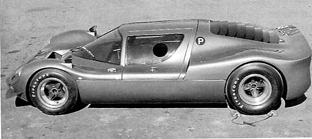
| Year
(of specifications) |
- |
| Engine |
Ford
mid-engined |
| Transmission |
- |
| Max
speed |
- |
| 0-60
mph |
- |
| Horsepower |
- |
| weight |
- |
Review by: Kevin:
I definitely remember this stunning little car and
being absolutely wowed by it's looks. The memory
is definitely fading but I saw an advertisement
in Motor Sport magazine. Now this would have been
around 1967 to 1970 and I can't be more definite
than that - we moved to the Wirral in 1967 and my
brother, who used to buy the magazine, left for
university in 1970. At that time I was into VW Beetles
and the beach buggies were just starting to appear
and I wondered if a Lenham GT body would fit on
to a VW pan. I did phone up to pose that question,
had a long chat but for the life of me I can't remember
the reply. However I was sent a brouchure I think
a two sided A4 sheet with that photograph on it
and I think one of the rear quarter. It was not
that long ago that I actually cleared out a lot
of papers and that brouchure was among them. I honestly
thought I would never see the car again and it certainly
brought back some memories (but not them all). Whatever
happened to it? How many if any were produced and
where are they now? Can anybody shed any light on
this car. It should really be in production today,
the styling is just timeless.
Mercedes-Benz 300SL Gullwing
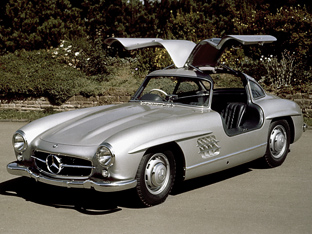
| Year
(of specifications) |
1954 - 1963 |
| Engine |
3.0
litre inline 6 cylinder |
| Transmission |
- |
| Max
speed |
130
- 150 mph |
| 0-60
mph |
- |
| Horsepower |
240
- 250 hp |
| weight |
- |
The Mercedes-Benz 300 SL Gullwing is one of the
most inspirational automotive designs of the 20th
century. Not only has the shape been imitated, so
have the dramatic doors and the "Gullwing"
name. The 300 SL also provided much of the styling
influence for the 2009 Mercedes-Benz
SLS AMG concept.
Upon its introduction in 1954 the 300SL was offered
solely as the "Gullwing" coupe. It came
equipped with an advanced, fuel-injected, 3.0 litre
straight 6 cylinder engine which produced 240 hp
@ 6,100 rpm. The engine longitudinally mounted engine
was tilted over at an angle in the engine bay which
meant the hood could stay low and smooth.
The only faults with the 300 SL Coupe were due to
its thoroughbred, race-derived technology which
made for unforgiving on-the-limit handling, and
expensive-to-repair spaceframe construction.
In 1957 Mercedes-Benz replaced the 300 SL Gullwing
coupe with the 300 SL Roadster. This car was essentially
the same, minus the fixed roof, and was fitted with
a slightly more powerful (+10hp) version of the
same engine. The suspension was also redesigned
to be more forgiving to the average driver and the
construction was simplified, making repair and maintenance
easier.
In total 1,400 300SL Gullwing coupes and 1,858 300SL
Roadsters were produced.
Pegaso Z102
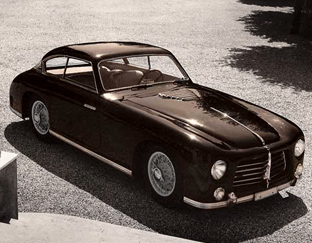
| Year
(of specifications) |
1951 - 1958 |
| Engine |
2.8,
3.2, 4.0, 4.5, 4.9 litre V8
some supercharged |
| Transmission |
5
speed manual AWD |
| Max
speed |
120
- 160 mph |
| 0-60
mph |
- |
| Horsepower |
175
hp - 360 hp |
| weight |
- |
The Z102 was the first automotive product of Pegaso,
a Spanish company based in Barcelona better known
for building trucks and buses. In the 1950s they
experimented briefly with manufacturing a limited
number of supercars and the Z102 was the result.
The Pegaso Z102 was first introduced in 1951. It
featured an aluminium body with graceful lines similar
to Italian and British marques of the time. Initially
the Z102 was powered by a 2.8 litre V8 with dry-sump
lubrication and a 5-speed gearbox.
Later there was a 3.2 litre V8 option which produced
230 bhp. Supercharged versions of both engines were
also offered, the 2.8 litre unit put out 280 hp
while the 3.2 litre engine developed 360 horsepower
- a massive amount in the 1950s.
Later the Z102 was developed into the Z103. This
model featured a larger displacement engine which
was less complicated and expensive to produce.
In total only around 100 Pegaso Z102 and Z103's
were produced from 1951 - 1958. Pegaso stopped making
supercars after this but they proved that if they
wanted to they could do them very, very well.
Piper GTT
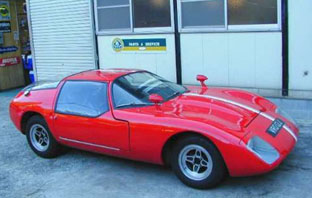
| Year
(of specifications) |
1970 |
| Engine |
1599
cc Ford unit |
| Transmission |
- |
| Max
speed |
110
mph |
| 0-60
mph |
8.0
seconds |
| Horsepower |
- |
| weight |
- |
The Piper GTT featured a fibreglass body built on
a Y shaped backbone tubular spaceframe chassis.
Running gear for the Piper GTT came courtesy of
Ford and Triumph.
Saab Sonett
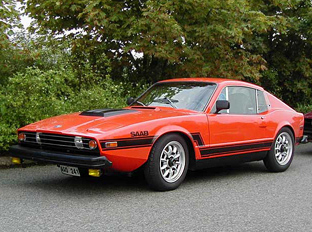
| Year
(of specifications) |
1966 - 1974 |
| Engine |
1.7
litre V4 (Sonett III) |
| Transmission |
4
speed manual FWD |
| Max
speed |
- |
| 0-60
mph |
- |
| Horsepower |
75
hp (Sonett III) |
| weight |
820
kgs / 1,785 lbs |
The Saab Sonett first went on sale in 1966 as the
Sonett II (the Sonett I never made it to the showrooms).
The Sonett II used the front-wheel-drive platform
of the Saab 96 saloon. But instead of a dull saloon
body the Sonett featured a distinctive coupe profile.
But to be fair the Sonett II wasn't the prettiest
car on the road.
One thing the Sonett II wasn't was fast. The first
generation car was fitted with an 841 cc engine
which only put out 60 horsepower, and the performance
it offered was a little underwhelming. Later versions
of the Sonett II faired slightly better thanks to
a new V4 engine which made 65 horsepower and considerably
more torque.
In 1970 the Sonett III was introduced. This iteration
of the model was significantly superior to the early
Sonett's. It had a 1.7 litre V4 engine which produced
75 horsepower @ 5,000 rpm and 94 lb-ft of torque
@ 2,500 rpm. The bodywork was also revised and improved
thanks to a change in supplier. The Sonett II got
its fiberglass body from a Swedish company which
normally made railway carriages. But the new suppliers,
Coggiola of Italy, were more adept at their trade
and the appearance improved as a result.
In 1974 production of the Sonett III ceased with
10,236 cars having rolled off the production line.
The primary reason for the model's discontinuation
were tighter safety and emissions regulations in
the US - the intended primary market for the car.
Redesigning the car to comply with the new rules
would have been too costly and uneconomical so Saab
killed it instead.
Sunbeam Tiger
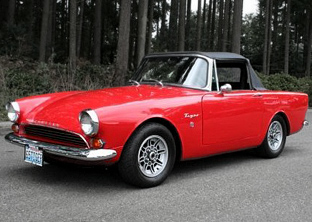
| Year
(of specifications) |
1964 - 1968 |
| Engine |
4.7
litre V8 |
| Transmission |
4
speed manual RWD |
| Max
speed |
- |
| 0-60
mph |
- |
| Horsepower |
200
horsepower |
| weight |
1,197
kgs / 2,640 lbs |
The Sunbeam Tiger which was introduced in 1964 was
a development of the Sunbeam Alpine. The car was
conceived out of a desire to produce something which
could rival the AC Cobra.
Inside the British-made chassis was a 4.2 litre
Ford V8 and a Borg-Warner 4-speed gearbox. All-in-all
it was a good combination which proved to be competitive
in a variety of races.
In 1967 the Sunbeam Tiger's engine was upgraded
to a 4.7 litre unit which produced 200 horsepower
- further improving the car's performance potential.
Sadly however, due to the fact Chrysler had recently
taken a financial stake in Sunbeam's parent company,
Rootes, the Tiger was discontinued later in the
year because Chrysler didn't want to be selling
a car powered by one of their competitors engines.
It's a shame they didn't bother trying to integrate
one of their own powerplants into the Tiger.
Toyota 2000GT
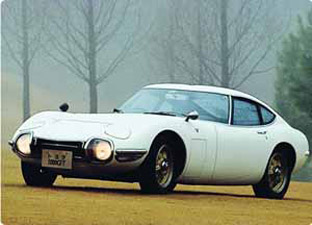
| Year
(of specifications) |
1967 - 1970 |
| Engine |
1998
cc |
| Transmission |
5
speed manual RWD |
| Max
speed |
137
mph |
| 0-60
mph |
8.4
seconds |
| Horsepower |
150
bhp |
| weight |
- |
There were only 337 Toyota 2000GT 's ever made.
The 2000GT 's beautiful aluminium body was designed
with assistance from Albrecht Goertz, who went on
to help in the production of the Datsun 240Z as
a consultant.
When it was new, the Toyota 2000GT cost $6,800.
Considerably more than the Porsche and Jaguar competition.
Nowadays the Toyota 2000GT is one of the most sought
after collector's car in the world.
WSM Healey 3000
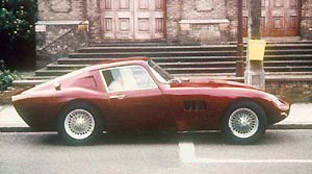
| Year
(of specifications) |
1965 |
| Engine |
Austin
Healey 3000 |
| Transmission |
- |
| Max
speed |
140
mph |
| 0-60
mph |
- |
| Horsepower |
- |
| weight |
- |
The WSM Healey 3000 was built on an Austin Healey
3000. After Malcom Bridgeland crashed his Healey
3000 at Silverstone he had WSM restyle his car into
the WSM Healey 3000, with the new aerodynamic body
the car was 12 mph faster than the standard Austin
Healey 3000.
The WSM 3000 survives in the UK, and designer Douglas
Wilson-Spratt was re-united
with the car in 2003 for the first time in 37 years.
For more information on the WSM 3000 and other WSM
cars please visit wsmcars.com
Information from: Tony Wilson-Spratt
|
|
|

